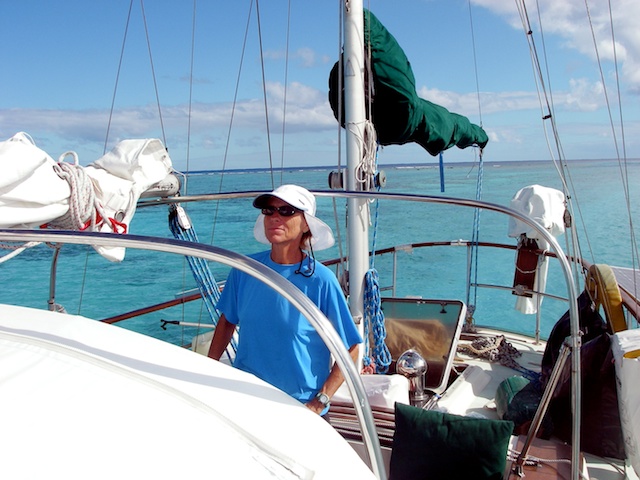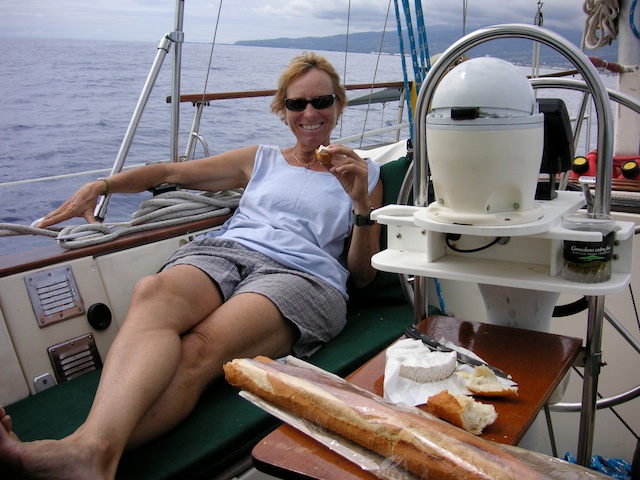Published in the Ocean Watch column, Honolulu Star-Advertiser © Susan Scott
April 15, 2013
OCEANIA, latitude 7N, longitude 120W » My voyage from Mexico to the Marquesas on my 37-foot sailboat, Honu, continues. This is Day 13 at sea with as many, or more, left to go.
About my long voyages, people often ask, What do you do all day?
It’s a hard question to answer. Sailing is a threefold experience: stretches of inactivity, punctuated by stabs of panic, followed by rushes of relief. Then boredom kicks back in and around I go again.
-
 Susan at the wheel of S.V. Honu (motoring, not sailing though)
Susan at the wheel of S.V. Honu (motoring, not sailing though)
During the unexciting hours, my two crew members and I read, listen to podcasts or watch videos, if the boat’s batteries permit.
Navigation gets voltage priority over everything else. Honu has electric autopilots that stay on course far better than we could on our own.
Our main autopilot, nicknamed Alphie, an Alpha 3000, died last week. Panic No. 1. But wait, I have a spare! Then that machine flatly refused to work. Panic No. 2. Oops, we had installed it backward. It is now driving just fine.
Compared with the silent Alphie, the spare is a Chatty Cathy, squawking with every tiny wheel movement. The sound is music to our ears. The alternative is that the three of us steer 24/7 for the next 1,700 or so miles.
Since we rotate three-hour night watches, we let ourselves nap during the day, a treat we rarely give ourselves at home.
-
 Susan enjoying some brie and baguette while the secondary autopilot steers.
Susan enjoying some brie and baguette while the secondary autopilot steers.
You can see the belt of the autopilot going up to the wheel in the
lower far right third of this picture. In French Polynesia 2005.
©2013 Susan Scott
The marine animals out here are sparse, but they’re here. We marvel over the 4- to 5-inch-long flying fish and squid that have leaped to the deck, photographing their winglike fins and tangles of tentacles, respectively, before we bury them at sea.
I thank the fish and squid for being here because they are the reason that we have our own escort of 10 to 20 seabirds, mostly red-footed boobies and two or three masked boobies. Tropicbirds — one red-billed and one red-tailed — fish near the boat, and we thrill over the wave-riding of shearwaters and storm petrels.
The boobies are extremely interested in the boat, craning their necks to look at it as they circle. We guess that the birds like the boat because its motion causes squid and flying fish to make their death leaps into the air. Poor things. If they don’t land on the boat, they end up in a bird’s gullet.
The birds can rest on the water, but they would rather ride on the boat. Much as I love seabirds, this is not a good thing. Their landing attempts have broken my mast-top weather vane and left poop stains on my jib.
“Land on the aft rail instead,” I call to them, but those rascals ignore me.
Our other main activity is staring at the always moving, always changing ocean. It’s the marine version of watching a campfire, except it never goes out.
The three of us aboard enjoy this do-nothing time, a break from our usual busy lives. “It’s nice to have nowhere to go, nothing that needs to be done and all the time in the world to do it,” said crew member John, a retired pediatrician.
Alex, a busy biologist, said, “It’s the only place in the world I can be completely unplugged. No phone calls, no email, no pressure. I can be quiet in all ways.”
What do we do all day? We soak up every aspect of the extraordinary experience of spending a month at sea.